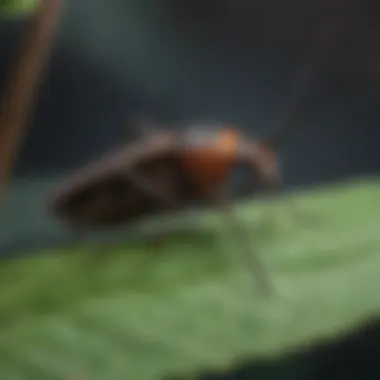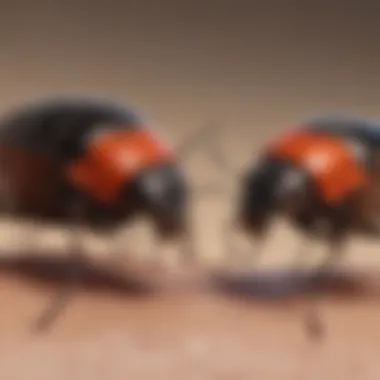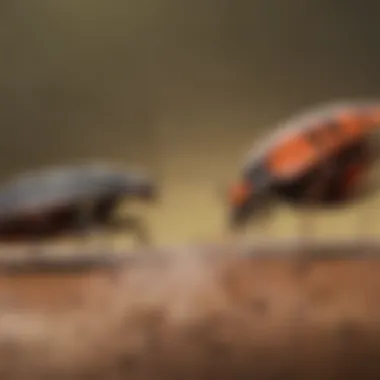Understanding Kissing Bug Bites: Identification and Implications


Intro
Kissing bugs, scientifically known as Triatominae, are often overlooked in discussions about pests that affect human health. Understanding these insects and their bites is necessary for proactive measures in prevention and treatment. In this article, various aspects of kissing bugs will be discussed, including their identification, the health implications of their bites, and significance in our environment.
Fascinating Facts About the Animal
Unique Characteristics
Kissing bugs are usually recognized by their elongated bodies and distinct markings. They possess a unique feature: the ability to feed on blood. Their mouthparts are adapted to pierce the skin, allowing them to consume blood from their hosts, which can include both animals and humans. They vary in size, with most species measuring between 1 to 4 centimeters in length. The colors also shift among species, ranging from dark brown to bright red depending on their habitat and evolutionary adaptations.
Extraordinary Abilities
One of the most notable abilities of kissing bugs is their capacity to transmit the Trypanosoma cruzi parasite, which causes Chagas disease. This disease can have serious health implications for those affected. Additionally, kissing bugs can detect heat and carbon dioxide, signaling the presence of potential hosts nearby. Their ability to eek out shelter, often in cracks and crevices, makes them especially challenging to eliminate in infested areas.
Behavior and Habitat
Natural Habitats
Kissing bugs thrive in diverse environments, including rural and urban areas. They are typically found in regions with warmer climates, often making their homes in areas with plenty of vegetation. These bugs often seek shelter in homes, particularly in the cracks of walls, under furniture, and around sleeping areas, making encounters with humans more likely.
Social Structures
Kissing bugs are generally solitary, but they may be found in groups under optimal environmental conditions. They are nocturnal, coming out primarily at night to feed. Their behavior tends to be governed by the need to locate hosts efficiently while minimizing exposure to threats.
Recent Scientific Discoveries
Latest Research Findings
Recent studies have focused on the epidemiology of Chagas disease and its relation to kissing bugs. Researchers are examining the geographic distribution of both the bugs and the disease. Understanding where kissing bugs reside can help manage and potentially reduce the occurrence of Chagas disease.
Breakthroughs in Animal Biology
Advancements in genetic studies have revealed how kissing bugs adapt to their environment over time. These findings are vital for developing strategies to control these pests and mitigate their health risks. A comprehensive understanding of their biology contributes to targeted efforts in public health initiatives.
Cultural Significance
Animals in Folklore
In various cultures, kissing bugs have sparked fear due to their association with disease. Folklore often depicts these insects in ominous ways, influencing public perceptions about their danger. Understanding this aspect helps inform communities about the realities of kissing bug encounters.
Influence on Art and Literature
Kissing bugs, while less common subjects, have appeared in literature and art that explore themes of disease and the natural world. Such works can help raise awareness about these insects and their potential health risks.
Kissing bugs pose significant health risks, but knowledge is essential to prevention and management.


By understanding the nature of kissing bugs and the implications of their bites, we can empower ourselves with the information necessary to recognize these insects and act accordingly.
Prolusion to Kissing Bugs
Kissing bugs, often found inhabiting various regions, play a significant role in public health discussions due to their association with Chagas disease. Understanding kissing bugs involves not only recognizing their biology but also being aware of their behavior and habits. These insects, known for their potential to impact human health, are frequently overlooked in everyday conversations about pests. By examining their characteristics, demographics, and potential consequences of their bites, individuals equipped with knowledge can better prepare themselves when encountering these insects.
Taxonomy and Distribution
Kissing bugs belong to the subfamily Triatominae, within the family Reduviidae. There are over 150 species, with Triatoma infestans being one of the most recognized due to its close association with Chagas disease. Their distribution is mainly found across the Americas, from the southern United States through Central America to South America. Their habitats range from rural areas, typically near livestock or domestic animals, to urban environments where conditions enable them to thrive.
Understanding the taxonomy and distribution of kissing bugs is important for both health professionals and families, as awareness can influence prevention strategies. For example, recognizing where these insects are prevalent can assist in taking necessary precautions in endemic areas or during travel.
Behavioral Traits
Behaviorally, kissing bugs are nocturnal, seeking out warm-blooded animals during the night to feed. They are attracted to carbon dioxide emissions, typically exhaled by humans and animals, which guides them to their food source. After feeding, they typically return to hiding places, often in cracks and crevices of homes, making them difficult to detect. Their feeding pattern can also highlight risks; bites usually occur during the night when individuals are asleep.
Moreover, their lifestyle emphasizes the importance of vigilance, especially in regions where Chagas disease is endemic. Being aware of their behavioral habits allows families to implement measures such as sealing entry points in homes and being cautious in outdoor activities.
Kissing Bug Bites: An Overview
Understanding kissing bug bites is essential, given their implications for human health and well-being. These bites often go unnoticed or are misidentified, leading to potential long-term health risks. Being informed enables individuals, families, and health professionals to recognize these bites quickly. Awareness is critical as it helps in initiating timely action, thereby reducing the likelihood of severe consequences.
What Constitutes a Kissing Bug Bite
A kissing bug bite typically occurs when the insect penetrates the skin with its elongated mouthparts. The bite is often mistaken for that of other insects, which can lead to confusion. Kissing bugs feed on blood, and their bites may occur during the night as they are primarily nocturnal.
The bite itself usually presents as a small, red, raised spot or cluster of spots, depending on the individual’s sensitivity and reaction. In some cases, a small puncture wound can be seen in the center of the bite. It is important to note that the severity and appearance of the bite can vary based on individual health factors and the specific kissing bug species.
Key Elements of Kissing Bug Bites:
- Puncture Wound: Identifiable by a small opening in the skin.
- Redness and Swelling: These reactions can result from the body’s immune response.
- Localized Itching: Common in response to the saliva injected during the bite.
Awareness of these characteristics can aid in distinguishing a kissing bug bite from other insect bites, allowing for appropriate management.
Common Symptoms Following a Bite
After a kissing bug bite, individuals may experience a range of symptoms. While some may have minimal reactions, others may notice significant discomfort. Symptoms can include swelling, redness, intense itching, or, in severe cases, systemic reactions.
- Localized Reactions: These may vary in intensity, ranging from mild irritation to moderate swelling around the bite site.
- Systemic Symptoms: Some individuals may experience headaches, fever, or malaise, indicating a more serious reaction or potential infection.
- Allergic Reactions: While rare, some might develop an allergic response leading to hives or more severe conditions.
It is essential to monitor symptoms carefully, as early intervention can prevent more serious health complications.
In summary, understanding the characteristics of kissing bug bites and their subsequent symptoms is critical for effective identification and management. This knowledge empowers individuals and communities to take necessary precautions and seek treatment when required.
Identifying Kissing Bug Bites
Identifying kissing bug bites is crucial for understanding the potential health implications associated with these insects. Awareness of the signs and symptoms allows individuals to respond promptly. Early identification plays a key role in preventing complications like Chagas disease. Moreover, recognizing the specific characteristics of the bites can help in proper management and treatment, protecting individuals from adverse health outcomes.


Visual Characteristics of the Bite
Appearance and Size
The appearance and size of a kissing bug bite are significant in recognizing it quickly. Typically, the volume of the bite may vary from person to person; however, most kissing bug bites present as small red welts. A critical characteristic is its size. These bites are often larger compared to typical insect bites. This size helps in distinguishing them from other bites. Knowing this can aid in initial identification, leading to more informed decisions concerning health.
Color Change Over Time
Color change is an important aspect when assessing a kissing bug bite. Initially, the bite may appear bright red. Over time, the color can shift to brown or darken. The progression of color change gives valuable insight into the bite's age and healing process. This characteristic can be useful in determining if the bite requires medical attention. Such visual cues help individuals understand whether symptoms are within a normal range or indicative of an underlying issue.
Possible Secondary Infections
Possible secondary infections that emerge following a kissing bug bite deserve attention. After the initial bite, some individuals may scratch, leading to potential infection. It's essential to monitor the bite area for increased swelling, pus, or other signs of complications. Recognizing these symptoms early can prevent more severe issues. Hence, it's key for individuals to understand that what appears as a simple bite can lead to more serious health consequences if not managed properly.
Demographics and Bite Patterns
Age Factors
Age factors can influence how individuals react to kissing bug bites. Older adults and children may exhibit stronger reactions compared to healthy adults. This aspect deserves careful consideration. Noting age dynamics is essential since young children or elderly individuals could face more significant health risks, making it paramount for caregivers to be vigilant.
Geographic Considerations
Geographic considerations help in understanding where kissing bug bites are more prevalent. Different regions exhibit varying populations of kissing bugs. Awareness of local species and their behaviors assists in anticipating encounters with these insects. Geographic knowledge is a significant factor in formulating effective prevention strategies. Individuals living in areas known for kissing bug populations should adopt more rigorous protective measures.
Time of Year Patterns
Time of year patterns can play an essential role in the likelihood of encountering kissing bugs. In many regions, these insects are more active during warmer months. Awareness of seasonal patterns allows individuals to prepare accordingly, particularly in terms of preventive strategies. Knowledge of these patterns enriches readers’ understanding of the behavior and potential risks associated with kissing bugs.
Health Risks Associated with Kissing Bug Bites
Kissing bug bites pose several health risks that should not be underestimated. Understanding these risks is essential for proper identification and response. Kissing bugs can carry parasites and allergens, making their bites potentially dangerous. By recognizing the implications of these bites, individuals can take preventive actions and seek medical advice when necessary.
Chagas Disease: A Major Concern
Transmission and Understanding the Disease
Chagas disease is primarily transmitted through the saliva of kissing bugs. When a kissing bug bites, it may defecate near the wound, introducing the Trypanosoma cruzi parasite into the bloodstream. This specific transmission method is crucial. It highlights the importance of properly identifying kissing bugs to avoid potential infection. Knowing the transmission route helps in raising awareness and promoting prevention strategies among at-risk populations.
Symptoms of Chagas Disease
Symptoms of Chagas disease can vary significantly from person to person. Initially, a mild reaction might occur at the bite site, including swelling, redness, or itching. However, some individuals might experience flu-like symptoms or more severe complications over time. Recognizing these symptoms early can lead to better management options. This aspect makes awareness of Chagas disease crucial for individuals living in or traveling to endemic areas.
Long-term Consequences
Long-term consequences of Chagas disease can be serious. If left untreated, the infection may lead to chronic conditions, including heart disease and digestive issues. Understanding these potential long-term effects stresses the need for early detection and treatment. Such knowledge encourages people to seek medical evaluation if they suspect exposure to kissing bugs.
Allergic Reactions to Kissing Bug Bites


Immediate Reactions
Immediate reactions to kissing bug bites can include swelling, redness, and intense itching at the bite site. These reactions are often similar to those caused by mosquito bites. Recognizing these immediate symptoms is beneficial. It allows individuals to differentiate between various types of insect bites they may encounter. Such awareness can guide appropriate treatment choices, enhancing overall public health responses.
Severe Allergic Responses
Severe allergic reactions to kissing bug bites can occur in some individuals. These responses may involve anaphylaxis, a life-threatening condition. The possibility of severe reactions underscores the importance of prompt recognition of symptoms and the need for immediate medical attention. By highlighting the potential for serious allergic responses, this topic raises significant awareness among healthcare providers and families alike.
Preventative Measures
Preventative measures against kissing bug bites include improving home maintenance and using protective clothing. Keeping homes free from clutter, sealing cracks, and using bug screens are effective strategies. When individuals proactively implement these measures, they significantly reduce the risk of bites and their associated health risks. This proactive approach is essential for communities prone to kissing bug infestations and can improve the health outcomes of vulnerable populations.
Prevention and Management of Kissing Bug Bites
Managing kissing bug bites is crucial to minimizing risks associated with these pests. Preventive measures not only help reduce the chances of bites but also promote awareness of the surroundings. Understanding the importance of this section helps individuals recognize the need for careful observation and strategic actions. The absence of biting might seem like a relief, but awareness will empower individuals to respond effectively if a kissign bug encounter occurs.
Preventive Strategies for Individuals
Home Maintenance Techniques
Home maintenance plays a pivotal role in minimizing the presence of kissing bugs. Keeping premises clean can prevent them from finding nesting areas indoors. Regular checks for cracks and openings are essential, as these insects can easily enter through breaches. The key characteristic of home maintenance techniques lies in their proactivity. A regular cleaning routine, combined with sealing potential entry points, forms a strong defense against infestation.
Unique features of these efforts include the usage of specific products designed to deter pests and the adherence to proper sanitation practices. These measures have substantial advantages, including reduced risk of bites and a general sense of security in living spaces.
Personal Protective Measures
Personal protective measures are also significant in this context. Wearing long sleeves and pants when outdoors, especially in areas where kissing bugs are prevalent, serves as a protective barrier. The key benefit of these strategies is their simplicity and effectiveness in reducing the risk of bites. Using insect repellent containing DEET on exposed skin before going outside provides an additional layer of security.
The unique aspect of personal protective measures involves their immediacy. Individuals can easily adapt their clothing habits and practices to suit their environment. These actions can be rapidly implemented, allowing individuals to feel secure in their immediate surroundings.
What to Do in Case of a Bite
First Aid Responses
Immediate first aid is critical following a kissing bug bite. Cleaning the affected area with soap and water reduces the risk of infections. The main characteristic of first aid responses is their accessibility. Most people can easily perform basic care on their own, making this approach beneficial and practical in urgent situations. Applying a cold compress can alleviate swelling or discomfort quickly, offering instant relief.
However, the disadvantage to consider is that first aid responses alone may not be sufficient if complications arise. Understanding the limitations empowers individuals to be prepared for more severe reactions or symptoms.
When to Seek Medical Help
Recognizing the right moment to seek medical help is essential after a kissing bug bite. Symptoms like persistent swelling, fever, or signs of allergic reactions indicate that immediate medical attention is necessary. Knowing when to seek assistance enhances individual safety and well-being. The primary benefit of understanding this point is that timely intervention often leads to better outcomes and prevents further complications.
The unique feature of this aspect is its critical role in health management. This knowledge allows individuals to make informed decisions regarding their health, reducing anxiety related to potential bites while promoting proactive health habits.
Finale
In summary, understanding kissing bug bites and their implications is essential for effective prevention and management. As highlighted throughout this article, knowledge of the specific characteristics of these bites equips individuals with the ability to identify potential risks early. The dangers associated with kissing bugs, such as the transmission of Chagas disease and allergic reactions, underscore the necessity of this awareness.
Furthermore, recognizing the various symptoms and manifestations of a bite can facilitate timely medical intervention. The information provided not only serves to protect individuals but also educates families about the potential health risks in their environment. It encourages proactive measures, such as home maintenance and personal protective strategies, which can significantly reduce the likelihood of encountering these insects.
Emphasizing prevention through education is pivotal. By familiarizing oneself with the identification of kissing bug bites, individuals can foster a safer living space. The significance of this topic extends beyond mere acknowledgment; it is about taking actionable steps to protect oneself and loved ones from the implications of kissing bug bites.
"Staying informed is the first line of defense against health risks associated with kissing bugs."







